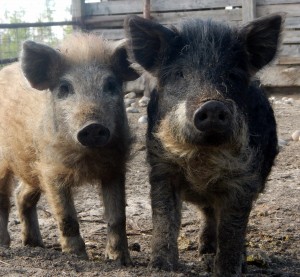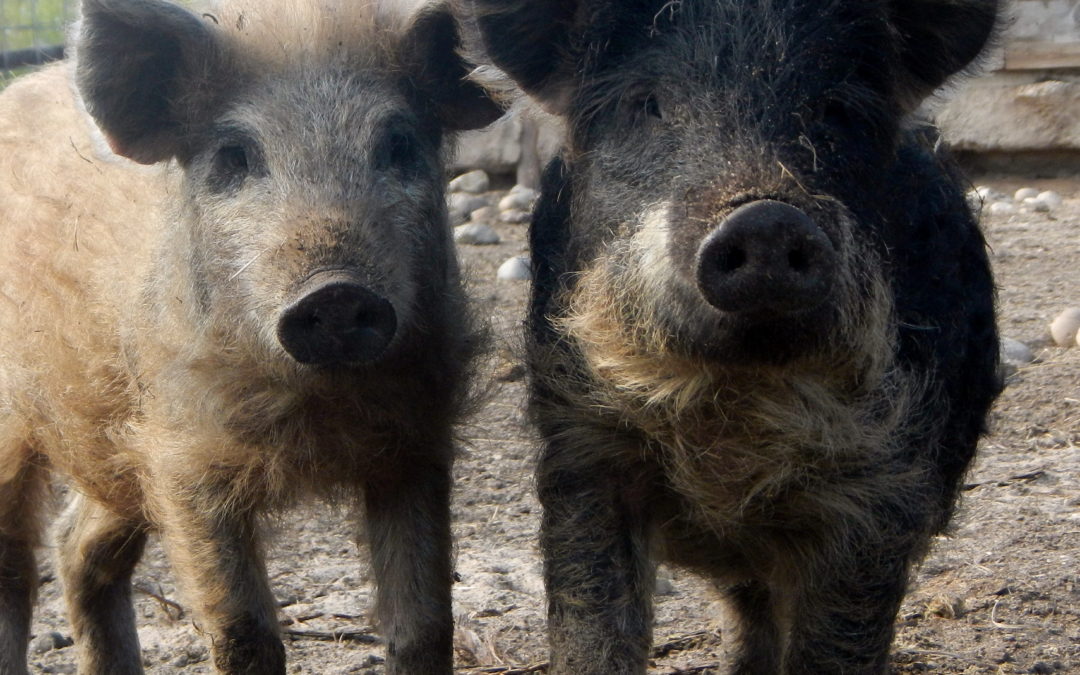As I have said before, the best part about having made the movie Farmageddon…The Unseen War on American Family Farms, is that whenever a farmer gets raided, I get to make a new friend.
That’s what happened when I met Mark Baker and his lovely wife Jill at the Weston Price Conference in Santa Barbara in 2012. Mark was the honorary speaker at the Farm to Consumer Legal Defense FUNDraiser, and winner of the “I’m not a doormat” award. The way to win that award, is to be raided by the government for running a farm, and to fight back.
Mark and Jill also donated the first course, which was a delicious Mangalitza tenderloin slow cooked with a BBQ sauce. I like high fat content personally, and the Mangalitsa’s have lots of fat and lots of flavor. In fact, many chefs, CSA owners and homemaker’s agree with that and seek it out. Mark and Jill and their 8 kids raise Mangalitsa pigs at their farm in Michigan. Their pig business became very successful, as high end restaurants and neighbors wanted the meat on their tables.

Mark, Jill and their eight kids raised these pigs outdoors. They were able to root in the dirt, run around on the farm, play, eat what they were supposed to eat and be pigs. None of Mark’s pigs have ever escaped from the farm.
However, the Department of Natural Resources in Michigan put out a declaration that basically said that all heritage breed hogs were “feral.” Wikipedia gives the definition of a feral animal as: (from Latin fera, “a wild beast”) is an animal living in the wild but descended from domesticated individuals. The state claimed that the Baker’s farmed pigs are a danger to Michigan, and needed to be shot. It didn’t matter if pigs were kept safely behind fences, and servicing the community by supplying meat to restaurants directly and to neighbors through CSA’s. It didn’t matter that the Bakers had a very sustainable business and that the Mangalitsa hog was embraced and wanted by people. The Baker’s were ordered to shoot all of their pigs. This would put them completely out of business.
They aren’t the only farm that is raising Mangalitsa. If you go into many high end restaurants in the US, you will see that this breed of pig is on the menu and that many chefs love them for their fat content and therefore incredible flavor. After the declaration, 250 farmers shot their heritage breed pigs, but Mark stood up for his rights and refused to shoot his animals.
We are watching this court case, which is coming up March 11th. If the state wins, we are afraid that other states will follow suit and ban these heritage breed hogs. The only pigs we will be allowed to eat will be factory farmed pigs.
How, I ask, can pigs that are being taken care of by a farmer behind fences, be deemed feral? How can we be asked to wipe out entire breeds of hogs? Is this Big Ag using their money to lobby our bureaucrats to kill off heritage breeds so that only pigs that can live inside are left? Cats are deemed feral when they live in the wild too…are we going to have to kill our cats soon? Or is this really about food and competition?
TO HELP SUPPORT MARK AND JILL’S FIGHT Go to: https://pledgie.com/campaigns/20620.html
Please see below the declaration from the Michigan DNR. It lists the distinguishing features of a “feral” hog. Pigs with any of these features could be outlawed and deemed feral, regardless of where they live. As you can see from the document taken right off of their website, it states that the pigs could either have a curly tail or a straight tail, be any variety of colors, have erect or floppy ears. They are using this document to subjectively turn Heritage Breed Hog farmers into criminals.
In its enforcement of the ISO and Part 413 of 1994 PA 451, as amended, the MDNR will use phenotype to identify Sus scrofa and distinguish it from other species. Identification may include use of one or more of the following characteristics (Mayer and Brisbin 2008):
- Bristle-tip coloration: Sus scrofa exhibit bristle tips that are lighter in color (e.g., white, cream, or buff) than the rest of the hair shaft. This expression is most frequently observed across the dorsal portion and sides of the snout/face, and on the back and sides of the animal’s body.
- Dark “point” coloration: Sus scrofa exhibit “points” (i.e., distal portions of the snout, ears, legs, and tail) that are dark brown to black in coloration, and lack light-colored tips on the bristles.
- Coat coloration: Sus scrofa exhibit a number of coat coloration patterns. Patterns most frequently observed among wild/feral/hybrid types are: wild/grizzled; solid black; solid red/brown; black and white spotted; black and red/brown spotted.
- Underfur: Sus scrofa exhibit the presence of underfur that is lighter in color (e.g., smoke gray to brown) than the overlying dark brown to black bristles/guard hairs.
- Declaratory Ruling -3- December 13, 2011
- Juvenile coat pattern: Juvenile Sus scrofa exhibit striped coat patterns. This consists of a light grayish-tan to brown base coat, with a dark brown to black spinal stripe and three to four brown irregular longitudinal stripes with dark margins along the length of the body.
- Skeletal appearance: Sus scrofa skeletal structure is distinct. Structures include skull morphology, dorsal profile, and external body measurements including tail length, head- body length, hind foot length, ear length, snout length, and shoulder height.
- Tail structure: Sus scrofa exhibit straight tails. They contain the muscular structure to curl their tails if needed, but the tails are typically held straight. Hybrids of Sus scrofa exhibit either curly or straight tail structure.
- Ear structure: Sus scrofa exhibit erect ear structure. Hybrids of Sus scrofa exhibit either erect or folded/floppy ear structure.
- Other characteristics not currently known to the MDNR that are identified by the scientific community.
Ongoing advancements in science may provide additional phenotypic or genotypic tools to aid in the identification of Sus scrofa. The MDNR may use these tools as they become available.
The MDNR may use previous inspection data for a facility, as well as advertisements that specify the existence of swine at a facility, as factors for determining whether a facility should be inspected for prohibited swine subject to the ISO.
Issued on this 13th day of December, 2011
Rodney A. Stokes Director
TO HELP SUPPORT MARK AND JILL’S FIGHT Go to: https://pledgie.com/campaigns/20620.html


I think bBigAg is behind this and wants to take cover everything even as more and more role are realizing how downright ignorant CAFO’s are as well as the rest of Earl Butts USDA legacy. The screaming of a dying monster ConAgra ArchetDaniels Midkand Monsanto and your chorines. Time to go before your ruin all of farming.
Dude, you seem like a great guy and you have a beautiful family. I wish I could help you financially but I can’t I will give you a word of advice though. Call your hogs “free range” pork. The idea of animals being allowed to have a good existence before they are harvested is a very popular concept among non farmers. “The government is against the raising of free range pork in favor of factory farms where hundreds of animals live on top of each other. Which would you prefer America?”
I think it’s another typical ploy of this government on the way to having all citizens slaves to their whims. They want everyone dependent on government totally. Don’t be self employed and successful at anything because that upsets and slows their goal of this dependency thing. Stand up to these jackass “progressives”. What a terrible thing to do…shoot Very intelligent animals because of what, really? That’s the Real question. It just gets worse every day~they have to be shown who the BOSS is.